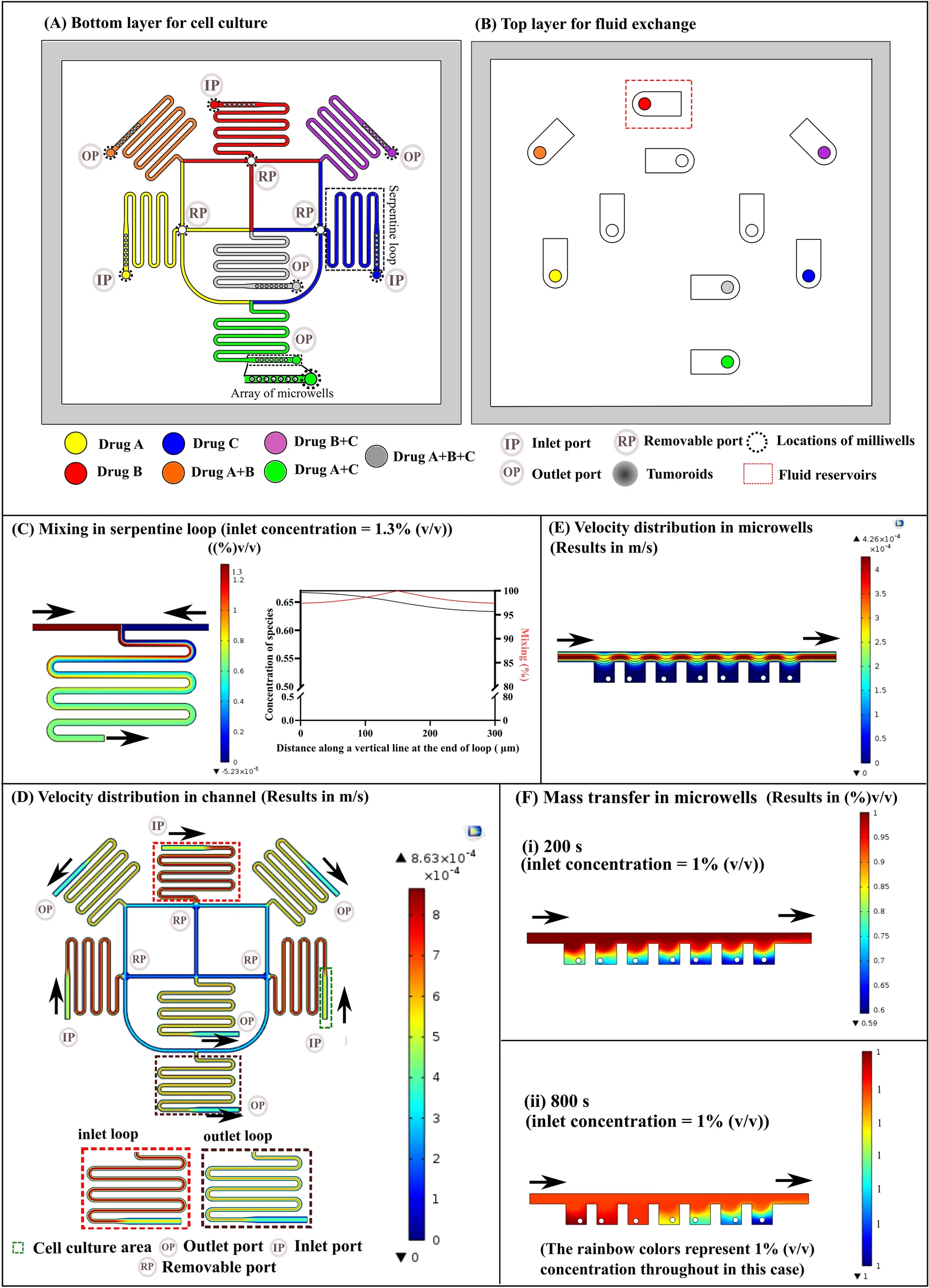
一种集成微芯片以评估PDT程序在三维肺细胞球培养物上的效率。
Introduction
标准癌症治疗方法,包括手术、化疗和放疗大多用于肺癌治疗。然而,这些方法并不总是有效。因此,需要应用一种额外的和可替代的治疗方法。光动力疗法(Photodynamic therapy, PDT)是一种新兴的方式,越来越多地被用于肺癌治疗。PDT的基础是使用光活性化合物(光敏剂),在有氧气的情况下,经过特定波长的照射后被激活。与其他疗法相比,PDT的副作用较小。这种抗癌方法被推荐作为0期(TisN0M0)和1期(T1N0M0)中心型肺癌的治疗选择。
一些光敏剂已经被批准用于肺癌治疗:
- 卟吩姆钠/porfimer sodium(光福啉/Photofrin):完全反应率为84.7%,但受限于皮肤光敏性和高成本设备。
- 单-L-天冬氨酰氯e6/mono-l-aspartyl chlorine e6(他拉泊芬/Laserphyrin):完全反应率为84.6%。
用于 PDT 的光活性化合物应满足:
- 光敏剂应选择性地积聚在肿瘤组织中。
- 应该具有最小的暗毒性,并且只有在特定波长的光存在时才具有毒性。
尽管已存在用于肺癌治疗的光敏剂,科学家们仍在不断寻找新的光活性化合物以及研究光敏剂的简单方法。
当前已有一部分研究显示某些化合物作为光敏剂对肺癌的有效性,相关报道仍在增加,因此科学家们仍在努力寻找新的方法和工具来快速验证光敏剂的特性。
本文作者使用A549癌细胞与MRC-5非恶性细胞球,分别测试了PDT处理后24 h与长期培养(10 d)的细胞球活性。
5-氨基乙酰丙酸(ALA)主要参与血红素合成途径,其中间产物为原卟啉IX(PpIX)。PpIX在红光照射下是光化学反应的催化剂,从而导致细胞死亡。
Development of the microchip
%20procedures%20in%20microfluidic%20Lab-on-a-Chip%20system/figure1.jpg)
- (A)微芯片的制作。每个微腔中有7个微孔用于细胞球培养。2对微腔用不同的入口/出口相连,可以在一次实验中设置对照(没有药物处理)与实验组。同时还配备了排气系统,可以从微通道中去除气泡。排气系统由位于主微通道中的排气孔组成。该系统的原理基于入口/出口1和通气孔之间的培养基交换。
- (B)0 h、24 h和48 h后微孔中细胞聚集和球形成的示意图。其中芯片用聚乙烯醇处理以抗细胞黏附。
- (C)微芯片布置方案。为了与酶标仪兼容,尺寸D1和D2与标准384孔板中的孔尺寸D1和D2一致。
- (D)含有芯片的支架并与384孔板进行比较。
Cell culture
%20procedures%20in%20microfluidic%20Lab-on-a-Chip%20system/figure2.jpg)
- (A)A549和MRC-5细胞球的共聚焦图像(沿Z轴)和荧光图。细胞被Calcein-AM和PI染色(绿色-活细胞,红色-死细胞)。图中显示沿细胞球直径的荧光强度(黄色-虚线)。
- (B)A549和MRC-5细胞球用抗粘着斑蛋白(Vinculin)的抗体染色。
Spheroid viability 24 h after PDT procedures
%20procedures%20in%20microfluidic%20Lab-on-a-Chip%20system/figure3.jpg)
- (A)没有光照处理的、不同浓度的ALA培养后,单层培养的A549和MRC-5细胞的活力。
- (B)PDT程序24 h后,不同浓度ALA的A549和MRC-5细胞球的活力。
- (C)PDT程序24 h后,不同浓度ALA的A549和MRC-5细胞球的死活染色。
PDT procedures efficiency on long-term spheroid culture
随后作者选择了用2 mM ALA进行PDT程序后的细胞球培养,因为该浓度导致了PDT程序后24小时A549细胞球活力的显著下降(低于80%)以及MRC-5细胞球的高活力(∼92%)。
%20procedures%20in%20microfluidic%20Lab-on-a-Chip%20system/figure4.jpg)
- (A)用2 mM ALA进行PDT程序后,A549和MRC-5细胞球在长期培养期间的活力以及在最后一天(第10天),A549和MRC-5细胞球的死活染色。
- (B)用3 mM ALA进行PDT程序后,A549和MRC-5细胞球在长期培养期间的活力以及在最后一天(第10天),A549和MRC-5细胞球的死活染色。可以发现,A549细胞球的存活率在细胞球培养的后几天内下降,而MRC-5细胞球的活力在培养的每一天都保持在较高的水平。
%20procedures%20in%20microfluidic%20Lab-on-a-Chip%20system/figure5.jpg)
黑暗条件下,A549和MRC-5细胞球在长期培养期间与3 mM ALA孵育后的活力以及在最后一天(第10天),A549和MRC-5细胞球的死活染色。在整个培养过程中注意到A549和MRC-5细胞球的高活力(~90%)。
ALA-induced PpIX accumulation and ROS level
%20procedures%20in%20microfluidic%20Lab-on-a-Chip%20system/figure6.jpg)
- (A)A549和MRC-5细胞球与3 mM ALA孵育4 h的图像。
- (B)A549和MRC-5细胞球与3 mM ALA孵育4 h的荧光强度。
%20procedures%20in%20microfluidic%20Lab-on-a-Chip%20system/figure7.jpg)
- (A)3mM ALA孵育的单层培养的A549和MRC-5在PDT程序前后的ROS生成。
- (B)3mM ALA孵育的芯片内的A549和MRC-5细胞球在PDT程序前后的ROS生成。研究表明,用ALA产生的PpIX经PDT程序在单层培养中引起的ROS生成比在细胞球培养中高(约1.7倍)。
Discussion
%20procedures%20in%20microfluidic%20Lab-on-a-Chip%20system/figure8.jpg)
图为单层培养和三维培养差别示意图,细胞球相对于单层培养的高抵抗力可能是由于它们的形态结构差异和细胞间通讯,从而增强了细胞球从不同类型的损伤中恢复。此外也有可能与细胞形状的变化和随后的基因表达变化(可能是基因修复)有关。
A549癌细胞对ALA的光动力疗法比正常MRC-5细胞更敏感。主要原因可能是正常细胞和癌细胞之间血红素循环中酶活性的差异,癌细胞比正常细胞更容易将ALA酶促转化为PpIX。同时,PpIX积累的差异也可以解释正常细胞和癌细胞之间ROS水平的差异,癌细胞中的ROS水平高于正常细胞,因此ROS水平可能对细胞抵抗力有影响,但未来应进一步研究细胞死亡机制。
长期细胞球培养的结果表明,在PDT程序后5天注意到显著且有效的光毒性作用,但这种毒性作用不可能是由3 mM ALA的作用引起的。由于细胞球的形态,在整个细胞球中积累光敏剂很困难,因此受试药物主要进入位于细胞球外部的细胞。根据所呈现的结果,不能得出ALA已到达细胞球中每个细胞的结论,但如果ALA从只进入细胞球外部的细胞,则只有那些细胞主要受到PDT程序的影响。
除了光活性药物的作用外,氧的存在对PDT效率也起着重要作用。在细胞球的外部注意到最高的氧含量,根据文献,缺氧细胞对光照射和PDT程序具有抵抗力。细胞球中心的氧含量较低,因此它会影响我们研究中获得的结果。然而应该指出的是,PDT效率也取决于光强度,如果光源足够强,氧气可能会耗尽并影响PDT效率。
结果表明,在ALA孵育和光照后几天观察到有效的PDT程序。3D培养和PDT参数可能会影响细胞死亡类型,这些细胞可能是凋亡的,这与观察到坏死细胞的单层细胞死亡的类型相反——凋亡细胞可能会在接下来的几天内死亡。此外,垂死的A549细胞可以从细胞球的外部分泌细胞内死亡信号(即TNF-α 因子)。可以得出结论,A549从球体外部释放的死亡因子可能对位于球体更深部分的细胞的活力产生影响。所呈现的结果表明,微流控芯片可以成为PDT程序评估及其参数优化的良好工具。然而,应更深入地研究细胞球中死亡细胞的机制。
Conclusion
在这项研究中,作者研究了ALA-PDT对芯片实验室系统中培养的A549(肺癌细胞)和MRC-5(非恶性肺细胞)细胞球的有效性。
- 微芯片的最大优点是三维细胞培养具有高细胞间相互作用。
- 微芯片的设计与酶标仪的兼容提供了快速定量地验证细胞球的活力的可能。
- 实验验证了PDT治疗后24小时以及长期培养。
注意到癌细胞对ALA-PDT比正常细胞更敏感;发现 PDT 在用3 mM ALA进行PDT处理后5天有效。
结果证实,在微芯片中培养的细胞球可以成为优化抗癌治疗参数的良好工具。此外它们可能有助于医生确定患者的 PDT 治疗程序。
Reference
Zuchowska A, Jastrzebska E, Chudy M, et al. 3D lung spheroid cultures for evaluation of photodynamic therapy (PDT) procedures in microfluidic Lab-on-a-Chip system[J]. Analytica Chimica Acta, 2017, 990: 110–120.
%20procedures%20in%20microfluidic%20Lab-on-a-Chip%20system/cover.jpg)



